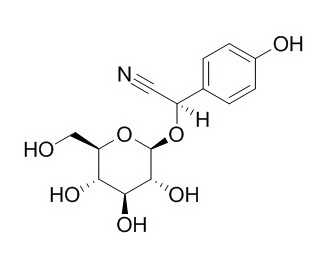Taxiphyllin
Taxiphyllin can inhibit tyrosinase activity in vitro significantly and is a potent tyrosinase inhibitor. Taxiphyllin displays mild antibacterial activity against Staphylococcus aureus.
Inquire / Order:
manager@chemfaces.com
Technical Inquiries:
service@chemfaces.com
Tel:
+86-27-84237783
Fax:
+86-27-84254680
Address:
1 Building, No. 83, CheCheng Rd., Wuhan Economic and Technological Development Zone, Wuhan, Hubei 430056, PRC
Providing storage is as stated on the product vial and the vial is kept tightly sealed, the product can be stored for up to
24 months(2-8C).
Wherever possible, you should prepare and use solutions on the same day. However, if you need to make up stock solutions in advance, we recommend that you store the solution as aliquots in tightly sealed vials at -20C. Generally, these will be useable for up to two weeks. Before use, and prior to opening the vial we recommend that you allow your product to equilibrate to room temperature for at least 1 hour.
Need more advice on solubility, usage and handling? Please email to: service@chemfaces.com
The packaging of the product may have turned upside down during transportation, resulting in the natural compounds adhering to the neck or cap of the vial. take the vial out of its packaging and gently shake to let the compounds fall to the bottom of the vial. for liquid products, centrifuge at 200-500 RPM to gather the liquid at the bottom of the vial. try to avoid loss or contamination during handling.
J Med Food.2019, 22(10):1067-1077
Metabolites.2019, 9(11):E271
Foods. 2022, 11(23):3905.
Int J Biol Macromol.2020, 161:1230-1239.
ACS Food Sci. Technol.2023, 3(2):273-282.
Molecules.2023, 28(16):6025.
Current Enzyme Inhibition2023, 19(1):55-64(10)
JABS2020, 14:2(2020)
Korean J. Crop Sci.2018, 63(2):131-139
J. Food Composition and Analysis2022, 114:104731
Related and Featured Products
J Biol Chem. 1981 May 10;256(9):4253-8.
The in vitro biosynthesis of taxiphyllin and the channeling of intermediates in Triglochin maritima.[Pubmed:
7012151]
The in vitro biosynthesis of the cyanogenic glucoside Taxiphyllin has recently been demonstrated in Triglochin maritima (Hösel, W., and Nahrstedt, A. (1980) Arch. Biochem. Biophys. 203, 753-757).
METHODS AND RESULTS:
We have now studied in more detail the multistep conversion of tyrosine into p-hydroxymandelonitrile, the immediate precursor of Taxiphyllin, catalyzed by microsomes isolated from dark-grown seedlings. The biosynthetic pathway involves N-hydroxytyrosine, p-hydroxyphenylacetaldoxime, and p-hydroxyphenylacetonitrile. In marked contrast to an analogous pathway in Sorghum bicolor, p-hydroxyphenylacetonitrile is the best substrate for cyanide production (Vmax = 224 nmol/h/g, fresh wt) and the physiological substrate tyrosine is the poorest (Vmax = 18.8 nmol/h/g, fresh wt). The substrates exhibit alkaline pH optima between 7.5 and 9, and all except tyrosine show pronounced substrate inhibition. We have found that p-hydroxyphenylacetonitrile generated in situ from tyrosine is free to equilibrate by diffusion with exogenous material. On the other hand, neither N-hydroxytyrosine nor p-hydroxyphenylacetaldoxime will readily exchange with exogenous intermediates.
CONCLUSIONS:
We consider both N-hydroxytyrosine and p-hydroxyphenylacetaldoxime to be channeled in T. maritima, whereas in S. bicolor N-hydroxytyrosine and p-hydroxyphenylacetonitrile are channeled and the aldoxime is freely exchangeable.
J. Nat. Prod.,2006:69(9):1366-9.
Phytochemical constituents from Salsola tetrandra.[Pubmed:
16989538 ]
METHODS AND RESULTS:
The new norisoprenoid 3beta-hydroxy-5alpha,6alpha-epoxy-beta-ionone-2alpha-O-beta-d-glucopyranoside (1) and the long-chain hydroxy fatty acids 9,12,13-trihydroxyoctadeca-10(E),15(Z)-dienoic acid (2) and 9,12,13-trihydroxyoctadeca-10(E)-dienoic acid (3) were isolated from Salsola tetrandra aerial parts, together with 3,4,5-trimethoxyphenyl-beta-d-glucopyranoside (4), 9-hydroxylinaloyl glucoside (5), Taxiphyllin (6), trans-N-feruloyltyramine (7), and S-(-)-trans-N-feruloyloctopamine (8). Their structures were elucidated by extensive spectroscopic analysis and chemical methods.
CONCLUSIONS:
Compounds 6 and 8 displayed mild antibacterial activity against Staphylococcus aureus, whereas compound 6 showed the highest activity in the Artemia salina bioassay.
Natural Product Research & Development, 2005, 17(6):733-725.
Taxiphyllin:A Cyanogenic Glucoside with Tyrosinase Inhibitory Activity from the Shoots of Pleioblastus amarus[Reference:
WebLink]
METHODS AND RESULTS:
A cyanogenic glycoside,Taxiphyllin (1),was isolated from the shoots of Pleioblastus amarus (Keng) Keng f.for the first time.It's structure was elucidated on the basis of spectroscopic analysis (UV,IR,MS,1D and 2D NMR) and physiochemical properties.
CONCLUSIONS:
Taxiphyllin was found to inhibit tyrosinase activity in vitro significantly and considered to be a potent tyrosinase inhibitor.



